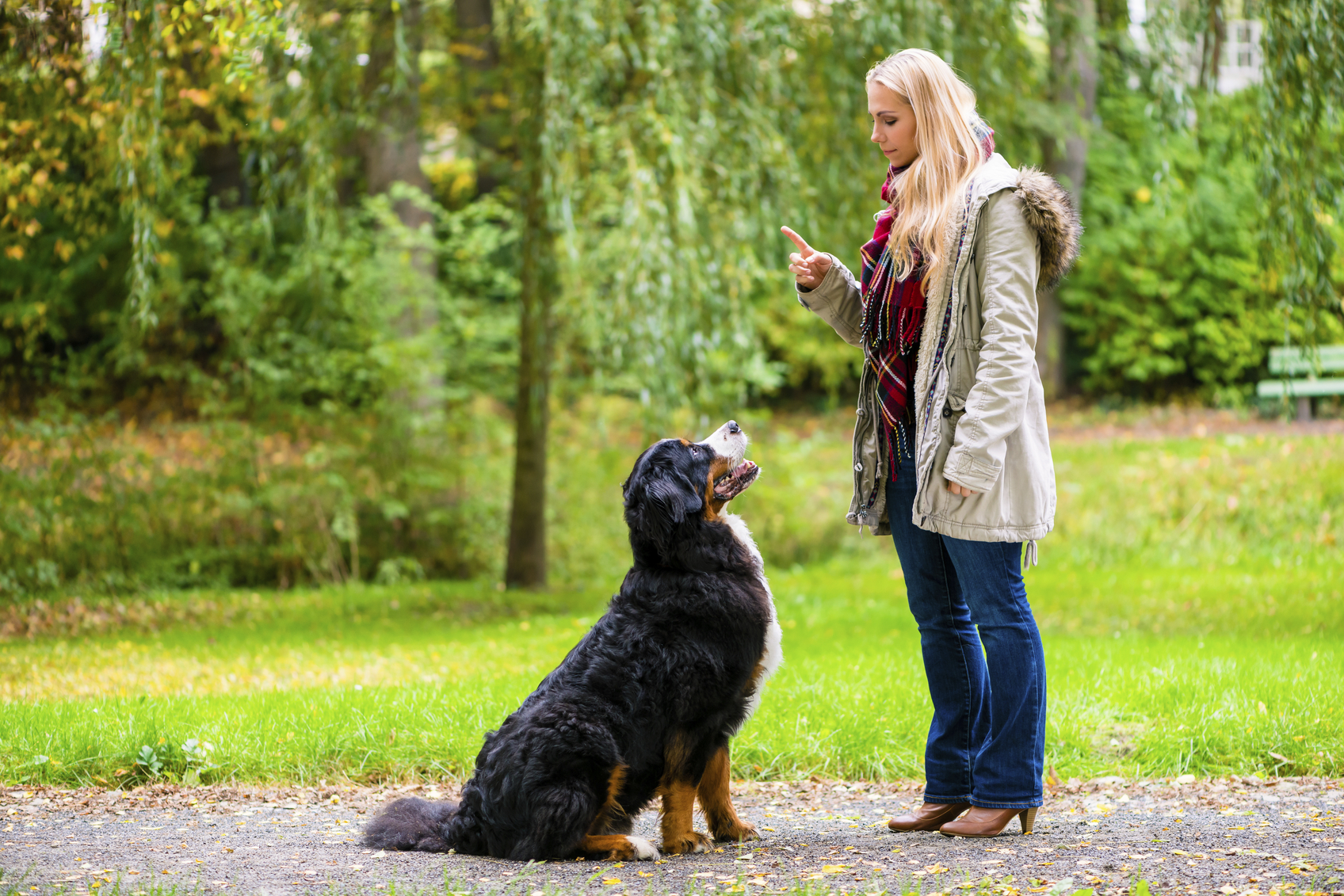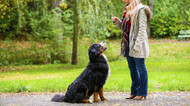
Your dog is your best friend, but how do your family members and neighbors feel about Fido? For a dog to be a good citizen, he or she must have good manners and understand a variety of commands. Your dog should be socialized, friendly and controlled.
Although dogs can learn hundreds of commands, our furry friends only need to know a few important ones to exist safely around other people and pets. Start working with your dog at home on the commands below, and join a dog-training class if possible. The outings are fun and they help dogs be sociable and reliable with distractions. And by the way… all dogs need training, even those cute little fluff balls!
Sit
This command is one of the easiest to teach, and is usually the first command introduced to a dog or puppy. Learning this command also helps the dog learn how to respond to training. Consider methods that are humane and positive. Most good programs use treats to motivate and reward dogs for appropriate responses to commands. Be sure to select a treat that is free of additives. The treats should also be chewable, like
CANIDAE® Grain Free PURE Chewy Treats with Turkey & Apple.
Down
Another practical command is down (lay down). This is great for all dogs, but especially for large dogs. When your dog learns to be comfortable in a down position, you can take him or her to the park or a sidewalk café. A dog that is relaxed in public is a non-threat to other people and pets and allows you the freedom to enjoy a good book or catch up with friends.
Stay
Of course, you will want to pair “stay” with sit and down. You are likely to cover sit- and down-stays up to a few minutes in a puppy training class, but your dog can learn to stay for up to a half hour or more with practice. The “stay” command comes in handy when you need your pup to stay put while you go to answer the door or sit down to wrap holiday gifts.
Come
This command is essential for every dog (and its owner) to master, because it could save his or her life. It is inevitable that even with diligence, your dog will one day escape through the front door or side gate or slip out of its leash. The “come” command protects him or her from traffic, neighbors, and encounters with other dogs.
Off
Never confuse “down” with “off.” Use the “off” command to teach your dog that jumping on people or climbing on furniture is inappropriate. This command is important for instructing your dog to keep calm on greetings, and to keep all four feet on the ground.
Don’t Touch
Curious dogs will find enticing objects wherever they go. Teach them to let go of found treasures when you say “don’t touch” or “leave it.” This command can also be used in the house, if your dog finds anything that is not meant for canine enjoyment.
Heel or Controlled Walking
Your dog is a nuisance if it pulls you down the street. Even the most exuberant dog should learn to pace himself to your speed in walking or jogging. There are many different training strategies you can use to teach your dog to walk by your side, and to stop and sit when you stop moving.
A big part of responsible pet ownership is making sure your dog understands basic commands. You can have a lot of fun training your dog, especially if you find a group of like-minded pet owners to train with. Add fetch, jump, and other tricks to your repertoire, and maybe you’ll be bitten by the competition bug. Regardless of your long-term goals, begin training as soon as you get your dog or puppy to establish good habits early on.
 Your dog is your best friend, but how do your family members and neighbors feel about Fido? For a dog to be a good citizen, he or she must have good manners and understand a variety of commands. Your dog should be socialized, friendly and controlled.
Although dogs can learn hundreds of commands, our furry friends only need to know a few important ones to exist safely around other people and pets. Start working with your dog at home on the commands below, and join a dog-training class if possible. The outings are fun and they help dogs be sociable and reliable with distractions. And by the way… all dogs need training, even those cute little fluff balls!
Sit
This command is one of the easiest to teach, and is usually the first command introduced to a dog or puppy. Learning this command also helps the dog learn how to respond to training. Consider methods that are humane and positive. Most good programs use treats to motivate and reward dogs for appropriate responses to commands. Be sure to select a treat that is free of additives. The treats should also be chewable, like CANIDAE® Grain Free PURE Chewy Treats with Turkey & Apple.
Down
Another practical command is down (lay down). This is great for all dogs, but especially for large dogs. When your dog learns to be comfortable in a down position, you can take him or her to the park or a sidewalk café. A dog that is relaxed in public is a non-threat to other people and pets and allows you the freedom to enjoy a good book or catch up with friends.
Stay
Of course, you will want to pair “stay” with sit and down. You are likely to cover sit- and down-stays up to a few minutes in a puppy training class, but your dog can learn to stay for up to a half hour or more with practice. The “stay” command comes in handy when you need your pup to stay put while you go to answer the door or sit down to wrap holiday gifts.
Come
This command is essential for every dog (and its owner) to master, because it could save his or her life. It is inevitable that even with diligence, your dog will one day escape through the front door or side gate or slip out of its leash. The “come” command protects him or her from traffic, neighbors, and encounters with other dogs.
Off
Never confuse “down” with “off.” Use the “off” command to teach your dog that jumping on people or climbing on furniture is inappropriate. This command is important for instructing your dog to keep calm on greetings, and to keep all four feet on the ground.
Don’t Touch
Curious dogs will find enticing objects wherever they go. Teach them to let go of found treasures when you say “don’t touch” or “leave it.” This command can also be used in the house, if your dog finds anything that is not meant for canine enjoyment.
Heel or Controlled Walking
Your dog is a nuisance if it pulls you down the street. Even the most exuberant dog should learn to pace himself to your speed in walking or jogging. There are many different training strategies you can use to teach your dog to walk by your side, and to stop and sit when you stop moving.
A big part of responsible pet ownership is making sure your dog understands basic commands. You can have a lot of fun training your dog, especially if you find a group of like-minded pet owners to train with. Add fetch, jump, and other tricks to your repertoire, and maybe you’ll be bitten by the competition bug. Regardless of your long-term goals, begin training as soon as you get your dog or puppy to establish good habits early on.
Your dog is your best friend, but how do your family members and neighbors feel about Fido? For a dog to be a good citizen, he or she must have good manners and understand a variety of commands. Your dog should be socialized, friendly and controlled.
Although dogs can learn hundreds of commands, our furry friends only need to know a few important ones to exist safely around other people and pets. Start working with your dog at home on the commands below, and join a dog-training class if possible. The outings are fun and they help dogs be sociable and reliable with distractions. And by the way… all dogs need training, even those cute little fluff balls!
Sit
This command is one of the easiest to teach, and is usually the first command introduced to a dog or puppy. Learning this command also helps the dog learn how to respond to training. Consider methods that are humane and positive. Most good programs use treats to motivate and reward dogs for appropriate responses to commands. Be sure to select a treat that is free of additives. The treats should also be chewable, like CANIDAE® Grain Free PURE Chewy Treats with Turkey & Apple.
Down
Another practical command is down (lay down). This is great for all dogs, but especially for large dogs. When your dog learns to be comfortable in a down position, you can take him or her to the park or a sidewalk café. A dog that is relaxed in public is a non-threat to other people and pets and allows you the freedom to enjoy a good book or catch up with friends.
Stay
Of course, you will want to pair “stay” with sit and down. You are likely to cover sit- and down-stays up to a few minutes in a puppy training class, but your dog can learn to stay for up to a half hour or more with practice. The “stay” command comes in handy when you need your pup to stay put while you go to answer the door or sit down to wrap holiday gifts.
Come
This command is essential for every dog (and its owner) to master, because it could save his or her life. It is inevitable that even with diligence, your dog will one day escape through the front door or side gate or slip out of its leash. The “come” command protects him or her from traffic, neighbors, and encounters with other dogs.
Off
Never confuse “down” with “off.” Use the “off” command to teach your dog that jumping on people or climbing on furniture is inappropriate. This command is important for instructing your dog to keep calm on greetings, and to keep all four feet on the ground.
Don’t Touch
Curious dogs will find enticing objects wherever they go. Teach them to let go of found treasures when you say “don’t touch” or “leave it.” This command can also be used in the house, if your dog finds anything that is not meant for canine enjoyment.
Heel or Controlled Walking
Your dog is a nuisance if it pulls you down the street. Even the most exuberant dog should learn to pace himself to your speed in walking or jogging. There are many different training strategies you can use to teach your dog to walk by your side, and to stop and sit when you stop moving.
A big part of responsible pet ownership is making sure your dog understands basic commands. You can have a lot of fun training your dog, especially if you find a group of like-minded pet owners to train with. Add fetch, jump, and other tricks to your repertoire, and maybe you’ll be bitten by the competition bug. Regardless of your long-term goals, begin training as soon as you get your dog or puppy to establish good habits early on.
